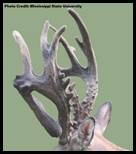|
|
| |
| Risk Factor |
-
The size and shape of antlers depends on sex, food, age, and
heredity.
-
Some of the reasons that antlers exhibit abnormal growth include:
-
inadequate nutrition;
-
injuries to antler-growing regions on the skull;
-
metabolic or hormonal deficiencies;
-
abnormal fetal development;
-
genetic predisposition;
-
injuries to velvet;
-
leg injuries.
|
| Images |
|
Click on images to enlarge. |
 |
 |
|
Abnormal antler growth in cervids. |
|
| Distribution |
|
Geographic: |
-
Antlers are unique to
cervids (deer family), and
deformities are commonly reported by hunters and wildlife
professionals throughout North America.
-
Anecdotally, they are more
commonly reported in white-tailed deer (Odocoileus
virginianus) than mule deer (Odocoileus
hemionus).
|
|
Seasonality: |
-
Deformities are reported throughout the period of the year when they are
present.
|
|
| Signs and Symptoms |
-
Abnormal antler growth
has been described variously as:
-
oddly shaped or
located points;
-
more points than
normal;
-
points not originating
from “normal” positions on the rack;
-
pronounced asymmetry.
|
| Meat Edible? |
-
Discounting other disease conditions, meat from deer with abnormal antler
development is considered just as edible as from deer with normal
antler development
|
| Human Health Concerns and
Risk Reduction |
-
There are no public health concerns associated with free-ranging
cervids with abnormal antlers.
|
| Samples for Diagnosis |
|
|
| Further Reading |
|
|
|
|

